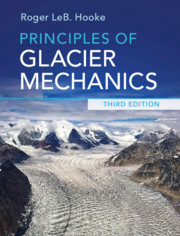Book contents
- Principles of Glacier Mechanics
- Reviews
- Principles of Glacier Mechanics
- Copyright page
- Dedication
- Contents
- Preface to the third edition
- Preface to the second edition
- Preface to the first edition
- Physical constants relevant to ice
- Derived SI units and conversion factors
- 1 Why study glaciers?
- 2 Some basic concepts
- 3 Mass balance
- 4 Flow and fracture of a crystalline material
- 5 The velocity field in a glacier
- 6 Temperature distribution in polar ice sheets
- 7 The coupling between a glacier and its bed
- 8 Water flow in and under glaciers: Geomorphic implications
- 9 Stress and deformation
- 10 Stress and velocity distribution in an idealized glacier
- 11 Numerical modeling
- 12 Applications of stress and deformation principles to classical problems
- 13 Ice streams and ice shelves
- 14 Finite strain and the origin of foliation
- 15 Response of glaciers to climate change
- 16 Ice core studies
- Problems
- References
- Index
13 - Ice streams and ice shelves
Published online by Cambridge University Press: 20 December 2019
- Principles of Glacier Mechanics
- Reviews
- Principles of Glacier Mechanics
- Copyright page
- Dedication
- Contents
- Preface to the third edition
- Preface to the second edition
- Preface to the first edition
- Physical constants relevant to ice
- Derived SI units and conversion factors
- 1 Why study glaciers?
- 2 Some basic concepts
- 3 Mass balance
- 4 Flow and fracture of a crystalline material
- 5 The velocity field in a glacier
- 6 Temperature distribution in polar ice sheets
- 7 The coupling between a glacier and its bed
- 8 Water flow in and under glaciers: Geomorphic implications
- 9 Stress and deformation
- 10 Stress and velocity distribution in an idealized glacier
- 11 Numerical modeling
- 12 Applications of stress and deformation principles to classical problems
- 13 Ice streams and ice shelves
- 14 Finite strain and the origin of foliation
- 15 Response of glaciers to climate change
- 16 Ice core studies
- Problems
- References
- Index
Summary
Active ice streams move one to two orders of magnitude faster than the ice bounding them, resulting in heavily crevassed shear margins. The high velocity of ice streams is attributed to lubrication by water at the glacier bed. Some shear margins are stabilized by valley walls, but others appear in places with no obvious underlying topographic control. The latter may be unstable against perturbations in the speed of the ice stream or in the influx of ice from outside the margin. Changes in basal hydrology can result in changes in ice stream width and velocity, and may result in shutting down the flow. Ice streams commonly transition into ice shelves in grounding zones, a few kilometers wide, in which coupling of the ice with the bed gradually diminishes. The stress and velocity distribution in ice shelves differs from that in grounded glaciers owing to the lack of any traction on the bed. The mass balance of ice shelves is affected by melting of the shelf base by sea water circulating beneath the shelf. Ice shelves can disintegrate in a matter of days or weeks when atmospheric temperatures are warm enough to result in appreciable melting on the shelf surface.
Keywords
- Type
- Chapter
- Information
- Principles of Glacier Mechanics , pp. 350 - 386Publisher: Cambridge University PressPrint publication year: 2019



